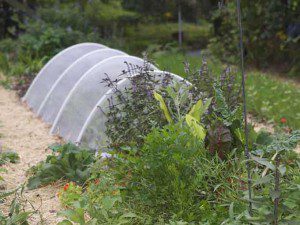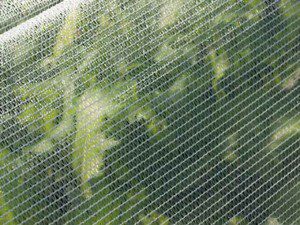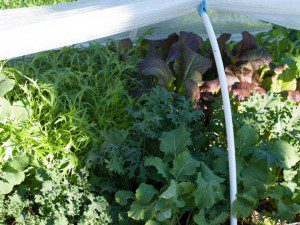The previous article looked at row covers, cold frames, cloches, and other techniques for protecting the garden during winter, but I wanted to take a closer look at one method in particular. While cold frames are still my favorite tools for cold weather gardening, the simpler row covers are gaining in favor because they are more versatile for general garden uses.
I believe that row covers have more practical applications and that they find uses in a wider range of climates than cold frames do. Row covers can provide some function and benefit to the gardener regardless of the season or climate they are gardening. And the latest fabrics that are being produced offer significant advantages over the original styles of row covers.
 The first decision to consider is what weight of fabric to choose, there are lightweights for use even during hot summer days, all-purpose medium weights, and finally the heavyweight gauges that provide greater frost resistance and retain more warmth under colder growing conditions. The various weights function differently based on the season involved and the goals that you apply them towards.
The first decision to consider is what weight of fabric to choose, there are lightweights for use even during hot summer days, all-purpose medium weights, and finally the heavyweight gauges that provide greater frost resistance and retain more warmth under colder growing conditions. The various weights function differently based on the season involved and the goals that you apply them towards.
The All-Purpose Garden Fabrics
These medium-weight fabrics are all-around performers that will hold heat, keep insects out, and allow about 70% of ambient light to pass through. Air and moisture have no difficulty penetrating the fabric to reach the plants underneath. These row covers also serve as a windbreak for young seedlings and can provide frost protection for plants down to around 28 degrees F.
The medium-weight garden fabrics are easy to handle, hold up relatively well, and if they are treated carefully you may be able to get more than a single season’s use out of them. They work nicely during the spring and fall seasons but are not as practical for summer and winter gardening.
Light-Weight Floating Row Covers
The lighter weight row covers are extremely sheer and allow around 85% of the sunlight to pass right through… there really isn’t much to them at all. They work well as “floating row covers” that lie directly on top of the plants because they are so lightweight. Their delicate make-up requires careful handling to avoid puncturing or tearing the fabric when in use.
The advantage of light weight row covers is that they do not hold much heat and are therefore safer to use during the summer months when temperatures rise. On the other hand they provide little if any frost protection and are not a good choice for fall or winter. I am not a big fan of summer-weight row covers but in specific situations they could come in handy and be useful.
Heavy-weight Row Cover Material
These are thicker grade fabrics that reduce the amount of light transmission down to about 60%. That can be a drawback when you consider that the heavy weight covers are typically used during times of the year when light levels are already on the decline. This weight is very durable and should provide multiple seasons of use.
The biggest plus from the heavier grade material is the frost protection down to about 24 degrees F, making these row covers best for fall and winter applications to extend the growing season in the garden.
The Latest Technology Brings New Advantages
The latest development in row cover materials are the woven types that have fibers arranged together in a mesh-like fashion. They function the same as the other fabrics but are much stronger and can be reused from one year to the next. The woven fabric is tear and puncture resistant to the point that it sometimes takes a bit of effort to even cut the material with a pair of scissors.
function the same as the other fabrics but are much stronger and can be reused from one year to the next. The woven fabric is tear and puncture resistant to the point that it sometimes takes a bit of effort to even cut the material with a pair of scissors.
The weight of the woven material that I used was closer to an all-season row cover but there are similar woven products being produced in various gauges to match the season or the intended uses. The only disadvantage that I’ve noted is that the woven fabrics are not as readily available on the market and may be difficult to locate.
Novel Uses for Row Covers in the Garden
Traditionally row covers have been used for frost protection and as an insect barrier but over time additional applications have been added to the list of uses for these garden fabrics. Here are a few ways that gardeners are experimenting with row covers as they come up with new and improved uses:
- Cover newly seeded beds to improve conditions for germination and encourage and even stand of seedlings.
- Serve as a windbreak so that young plants have less stress are they are becoming established out in the garden.
- Use as a barrier to prevent wildlife from attacking plants; I’ve used row covers in this manner to discourage rabbits and birds.
- Provide warmer air and soil temperatures for heat loving garden crops such as northern grown sweet potato plants.
 So there are many new and interesting uses for row covers but for me the biggest draw is the quality of the plants that I have grown underneath of garden fabrics. There isn’t one thing or reason that I can point to that made the difference but row covers have helped me to produce some outstanding crops of leafy greens.
So there are many new and interesting uses for row covers but for me the biggest draw is the quality of the plants that I have grown underneath of garden fabrics. There isn’t one thing or reason that I can point to that made the difference but row covers have helped me to produce some outstanding crops of leafy greens.
The plants just seem to enjoy the cozy environment that row covers provide. Whether it’s the result of additional warmth, taking an edge off the intensity of sunlight, adding a little boost in humidity levels, or just reducing the amount of wind that buffets the plants; row covers are definitely good for more than just frost protection or keeping insects at bay.



 Address:
Address: EMAIL:
EMAIL: Telephone:
Telephone: